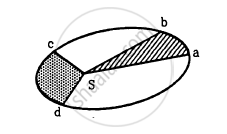Advertisements
Advertisements
Question
Let us assume that our galaxy consists of 2.5 × 1011 stars each of one solar mass. How long will a star at a distance of 50,000 ly from the galactic centre take to complete one revolution? Take the diameter of the Milky Way to be 105 ly
Solution 1
Mass of our galaxy Milky Way, M = 2.5 × 1011 solar mass
Solar mass = Mass of Sun = 2.0 × 1036 kg
Mass of our galaxy, M = 2.5 × 1011 × 2 × 1036 = 5 ×1041 kg
Diameter of Milky Way, d = 105 ly
Radius of Milky Way, r = 5 × 104 ly
1 ly = 9.46 × 1015 m
∴r = 5 × 104 × 9.46 × 1015
= 4.73 ×1020 m
Since a star revolves around the galactic centre of the Milky Way, its time period is given by the relation:
`T = ((4pi^2r^3)/(GM))^(1/2)`
= `((4xx(3.14)^2xx (4.73)^2 xx 10^(60))/(6.67xx10^(-11)xx5xx10^(41)))^(1/2) = ((39.48xx105.82xx10^(30))/33.35)^"1/2"`
= `(125.27 xx 10^(30))^(1/2) = 1.12 xx 10^(16) s`
1 year = `365 xx 324 xx 60 xx 60 s`
1s = `1/(365xx24xx60xx60)` year
`:.1.12xx10^(16) s = (1.12 xx 10^(16))/(365xx24xx60xx60)`
= `3.55 xx 10^8` year
Solution 2
Here, r = 50000 ly = 50000 x 9.46 x 1015 m = 4.73 x 1020 m
M = 2.5 x 1011 solar mass = 2.5 x 1011 x (2 x 1030) kg = 5.0 x 1041kg
We know that
`M =(4pi^2r^3)/(GT^2)`
or` T = ((4pi^2r^3)/"GM")^(1/2) = [(4xx(22/7)^2xx(4.73xx10^(20))^3)/(6.67xx10^(-11)xx(5.0xx10^(41)))]^(1/2)`
= `1.12 xx 10^(16)` s
APPEARS IN
RELATED QUESTIONS
A Saturn year is 29.5 times the earth year. How far is the Saturn from the sun if the earth is 1.50 ×108 km away from the sun?
In the Following figure shows the elliptical path of a planet about the sun. The two shaded parts have equal area. If t1 and t2 be the time taken by the planet to go from a to b and from c to d respectively,

Answer the following question.
State Kepler’s law of equal areas.
Answer the following question in detail.
State Kepler’s three laws of planetary motion.
Observe the given figure and answer these following questions.

The orbit of a planet moving around the Sun
- What is the conclusion about the orbit of a planet?
- What is the relation between velocity of planet and distance from sun?
- Explain the relation between areas ASB, CSD and ESF.
If the distance between the sun and the earth is made three times, then attraction between the two will ______
The mass and radius of earth is 'Me' and 'Re' respectively and that of moon is 'Mm' and 'Rm' respectively. The distance between the centre of the earth and that of moon is 'D'. The minimum speed required for a body (mass 'm') to project from a point midway between their centres to escape to infinity is ______.
If the sun and the planets carried huge amounts of opposite charges ______.
- all three of Kepler’s laws would still be valid.
- only the third law will be valid.
- the second law will not change.
- the first law will still be valid.
Out of aphelion and perihelion, where is the speed of the earth more and why?
Halley's Comet revolves around the sun for a time period of 76 years. The aphelion distance if perihelion is given by 8.9 × 1010 m, will be ______.
(Take, the mass of sun = 2 × 1030 kg and G = 6.67 × 10-11 Nm3/kg2)
